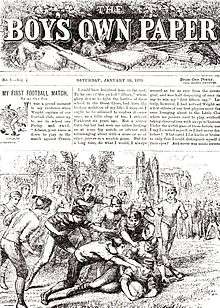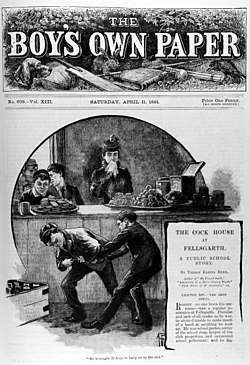The Boy's Own Paper
 Issue No. 1, 18 January 1879 | |
| Categories | Story paper |
|---|---|
| First issue | January 18, 1879 |
| Final issue | 1967 |
| Country | United Kingdom |
| Language | English |
The Boy's Own Paper was a British story paper aimed at young and teenage boys, published from 1879 to 1967.
Publishing history
The idea for the publication was first raised in 1878 by the Religious Tract Society, as a means to encourage younger children to read and also instil Christian morals during their formative years. The first issue was published January 18, 1879.
In 1939 it was taken over by Lutterworth Press, and in 1963 by Purnell and Sons Ltd. It was published at the end of its life in 1967 by BPC Publishing Ltd, who are believed to have started publishing the paper in 1965.[1]
The paper was published weekly following the school year (Autumn through to Summer) until November 1913, when it became a monthly. In total, 2511 issues of the paper were published.[1] From 1879 onwards each year's issues were bound together and sold as the Boy's Own Annual. In the initial few years, one could purchase the covers at the end of the publishing year and have the weekly issues bound. This produced some interesting minor variations in order and contents.
The Annuals ceased publication after the 1940–41 edition due to wartime paper rationing. The Annuals included all of the text of the weekly (and later monthly) issues, with additional illustrations. There was an extra Christmas Number (edition) magazine from 1884–85 until 1912–13 and an extra Summer Number from 1884–85 until 1900–01. Later attempts at a smaller format annual, under Jack Cox's editorship, were the Boy's Own Companion from 1959 through 1963, and the Boy's Own Annual II from 1964–65 through 1975–76.
Contents

Often published were adventure stories; notes on how to practise nature study, sports and games; puzzles; and essay competitions. One of the stories in the opening issue was "My First Football Match", the first of many by Talbot Baines Reed set in public schools (Reed, who had not in fact attended such a school, later became the paper's first assistant editor); and the first volume's serials included "From Powder Monkey to Admiral, or The Stirring Days of the British Navy". In the same volume, Captain Matthew Webb contributed an account of how he swam the English Channel.
In the first decade the paper unselfconsciously promoted the British Empire as the highest achievement of civilization, and reflected fully the racist attitudes which were taken for granted in Britain at the time. In 1885, for example, it described its vision of "the typical negro":
- "The arm is two inches longer in proportion than that of a Caucasian, and the hands hang level with the kneecaps; the facial angle is seventy as against eighty three, the brain weighs thirty five as against forty five; the skull is much thicker ... there is no growth in intelligence once manhood is reached."[2]
The paper initially attempted to appeal to boys of all classes, but by the 1890s began to concentrate on boys from wealthier backgrounds.
Contributors
Many prominent authors contributed to the paper. W.G. Grace wrote for several issues, along with Arthur Conan Doyle, Jules Verne and R.M. Ballantyne. Robert Baden-Powell, founder of the Scout Movement, was a regular columnist and urged readers "to live clean, manly and Christian lives". Less well-known writers included William Gordon Stables, W. E. Cule, Sid G. Hedges and Hugh Pembroke Vowles. Edward Whymper contributed engravings (including the masthead). Gilbert Davey, who went on to publish Fun with Radio introduced many youngsters to a future career in Radio and Electronics.
Between 1941–61 there was 60 issues with stories about Biggles by W. E. Johns.[3]
In the 1960s other occasional contributors included Isaac Asimov and the respected astronomer Patrick Moore, who contributed several articles about the solar system and would answer boys' questions on astronomical matters in the "You Ask Us" section of the paper.
Editors
Editors of Boy's Own Paper:[1]
- 1879 – 1897: James Macaulay (Supervising Editor)
- 1879 – 1912: George A. Hutchison (Sub-editor/Acting-editor, subsequently Editor)
- 1912 – 1913: George Andrew Hutchison (Consulting Editor)
- 1912 – 1924: Arthur Lincoln Haydon
- 1924 – 1933: Geoffrey Richard Pocklington
- 1933 – 1935: George J.H. Northcroft
- 1935 – 1942: Robert Harding
- 1942 – 1946: Leonard Halls
- 1946 – 1967: Jack Cox
Other papers of the same title

From 1855 through 1920, there were in total over a dozen serials using the title Boys Own.[4] The first and most influential was Samuel Beeton's weekly Boy's Own Magazine, published from 1855 to 1890.[5][6] Another was an American publication named The Boys' Own, published by Charles F. Richards in Boston, Massachusetts from October 1873 through December 1876.
Boy's Own Paper was also printed in Toronto, Ontario, Canada by the publisher W. Warwick and Sons. These were identical to the British editions, except for a four-page "cover", dated one month later than the contents, which contained ads for Toronto businesses. Examples of these "reprints" have been noted for August 1884 and August 1885.[7]
In contemporary popular culture
In British popular culture, improbable or daring endeavours are often described as "real Boy's Own stuff", in reference to the heroic content of the magazine's stories. Alternatively, many associate the magazine with well-intentioned heroes who do not have inhibitions about trying to right wrongs.
In the 1989 book Great Work of Time, dealing with an alternative history of the British Empire, writer John Crowley depicts Cecil Rhodes as avidly reading Boy's Own Magazine when he was no longer a boy but at the peak of his empire-building career.
Quotes
| “ | A small boy in one of our large industrial towns once asked me, 'What does it feel like to play for England?' I could see that he was puzzled and very, very interested. 'Do you play soccer, son?' I asked him. He nodded. 'Then you know what it's like to play for England. Every boy in England who does his best to play a good clean, worth-while game is playing for his country.'[8] | ” |
| “ | Most boys like to think they have a girl friend, especially the 13 to 14 year olds. I would like to see an article on how to get a girl, and when you've got her, how to keep and please her. I would also like to see more articles on music in B.O.P. as I am a trombonist in the Tiffin School Band.
R. Wilmot (New Malden, Surrey) Editor's Reply : We will bear the suggestion for an article on how to keep a girl friend in mind! In the meantime there is an article on keeping Golden Hamsters on pages 34 and 35 of this issue.[8] |
” |
Notes
- 1 2 3 "Magazine Data File". www.philsp.com.
- ↑ Wascana Review, Volumes 12–14. University of Saskatchewan, 1977. p. 87.
- ↑ rogerharris@biggles.info. "Boys Own Paper featuring the work of Captain W E Johns". www.boysown.info. Retrieved 2017-06-07.
- ↑ Boys Own. Alphabetical listing of various serials under that title – see The Boys' Own through Boys' Own Times and News of the World.
- ↑ "Magazine Data File". www.philsp.com.
- ↑ Tosh, John. MASCULINITY, 1560–1918: MEN DEFINING MEN AND GENTLEMEN. Part 3: 1800–1918, Sources from the Bodleian Library, Oxford. Adam Matthew Publications.
- ↑ Nash, Andrew. "Jules Verne: Boys Own Paper / Boys Own Annual - ANash". www.julesverne.ca.
- 1 2 "The Boy's Own Paper". www.collectingbooksandmagazines.com.
References
- Cox, Jack (1982). Take a Cold Tub, Sir!: the story of The Boy's Own Paper. Guildford: Lutterworth Press. ISBN 0-7188-2505-5.
- Boyd, Kelly (2003). Manliness and the boys' story paper in Britain: a cultural history, 1855-1940. Basingstoke: Palgrave Macmillan. ISBN 0-333-64172-8.
- Sabbagh, Karl (2007). Your Case is Hopeless: bracing advice from The Boy's Own Paper. London: John Murray. ISBN 978-0-7195-2472-1.